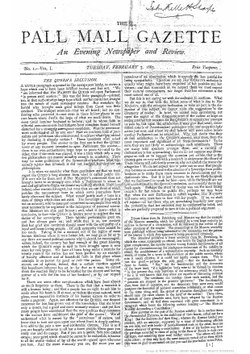History
The Pall Mall Gazette took the name of a fictional newspaper conceived by W. M. Thackeray. Pall Mall is a street in London where many gentlemen's clubs are located, hence Thackeray's description of this imaginary newspaper in his novel The History of Pendennis (1848–1850):
We address ourselves to the higher circles of society: we care not to disown it—The Pall Mall Gazette is written by gentlemen for gentlemen; its conductors speak to the classes in which they live and were born. The field-preacher has his journal, the radical free-thinker has his journal: why should the Gentlemen of England be unrepresented in the Press?
Under the ownership of George Smith of Smith, Elder & Co. from 1865 to 1880, with Frederick Greenwood as editor, The Pall Mall Gazette was a Conservative newspaper. Greenwood resigned in 1880, when the paper's new owner (Smith's new son-in-law, Henry Thompson) wished for it to support the policies of the Liberal Party. [1] Taking all the staff with him, Greenwood became the editor of the newly-founded St James's Gazette and maintained his advocacy of Conservative policy. [2] [3] The first editor under Thompson's ownership was John Morley (later Viscount Morley), with W. T. Stead as assistant editor. Morley resigned in 1883 to go into politics. [4]
Stead's editorship from 1883 to 1889 saw the paper cover such subjects as child prostitution; his campaign compelled the government to increase the age of consent from 13 to 16 in 1885. This was one of the first examples of investigative journalism, and Stead was arrested for "unlawful taking of a child" (when he purchased thirteen-year-old Eliza Armstrong from her mother for the meagre price of £5, to highlight how easy it was to buy children). The affair distressed Thompson, who dismissed Stead and hired the handsome society figure Henry Cust to replace him. Editor from 1892 to 1896, Cust returned the paper to its Conservative beginnings.
Thompson sold the paper to William Waldorf Astor in 1896. Sir Douglas Straight was editor until 1909, followed by F. J. Higginbottom, under whom the paper declined. Circulation doubled between 1911–15 under the editor James Louis Garvin, but the paper declined once more under its last editor D. L. Sutherland. It was absorbed into the Evening Standard in 1923. [5]
Several well-known writers contributed to The Pall Mall Gazette over the years. George Bernard Shaw gained his first job in journalism writing for the paper. Other contributors included Anthony Trollope, Friedrich Engels, Oscar Wilde, Robert Louis Stevenson, Charles Whibley, Sir Spencer Walpole, Arthur Patchett Martin, [6] and Jamaican-born writer Eneas Sweetland Dallas.
The British Weekly , "one of the most successful religious newspapers of its time", followed stylistically in the footsteps of the Pall Mall Gazette, "including interviews of prominent personalities, use of line illustrations and photographs, special supplements, investigative reporting, sensationalist headlines, and serialised debates". [7]
This page is based on this
Wikipedia article Text is available under the
CC BY-SA 4.0 license; additional terms may apply.
Images, videos and audio are available under their respective licenses.
